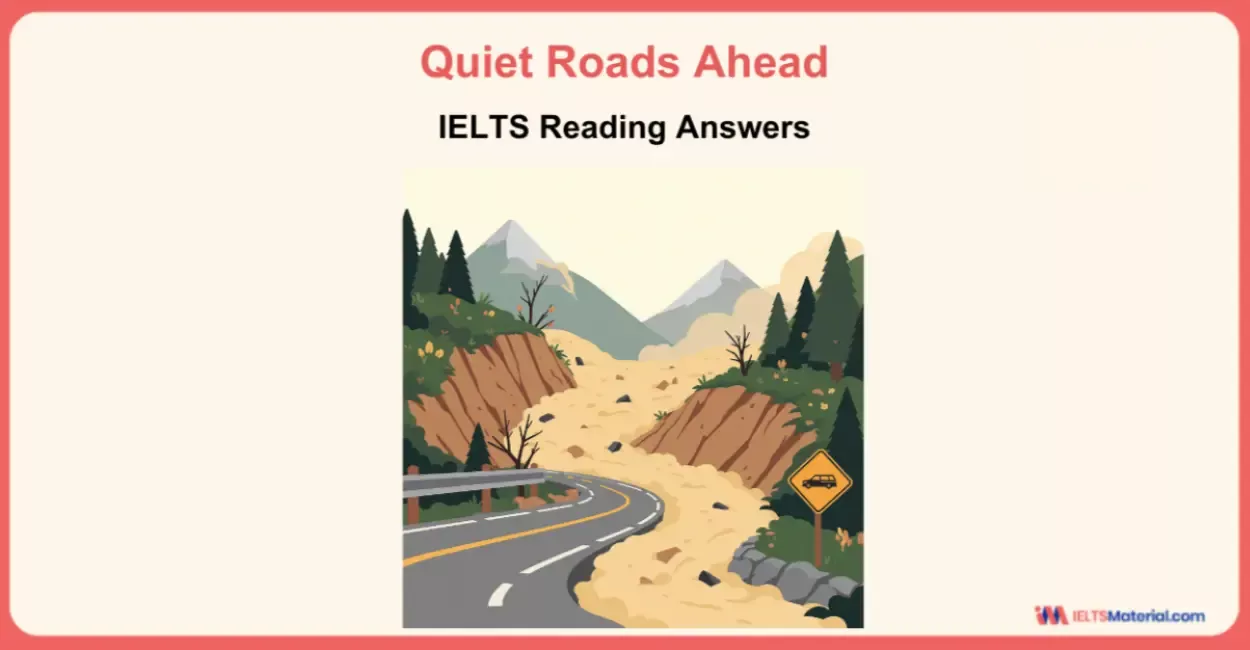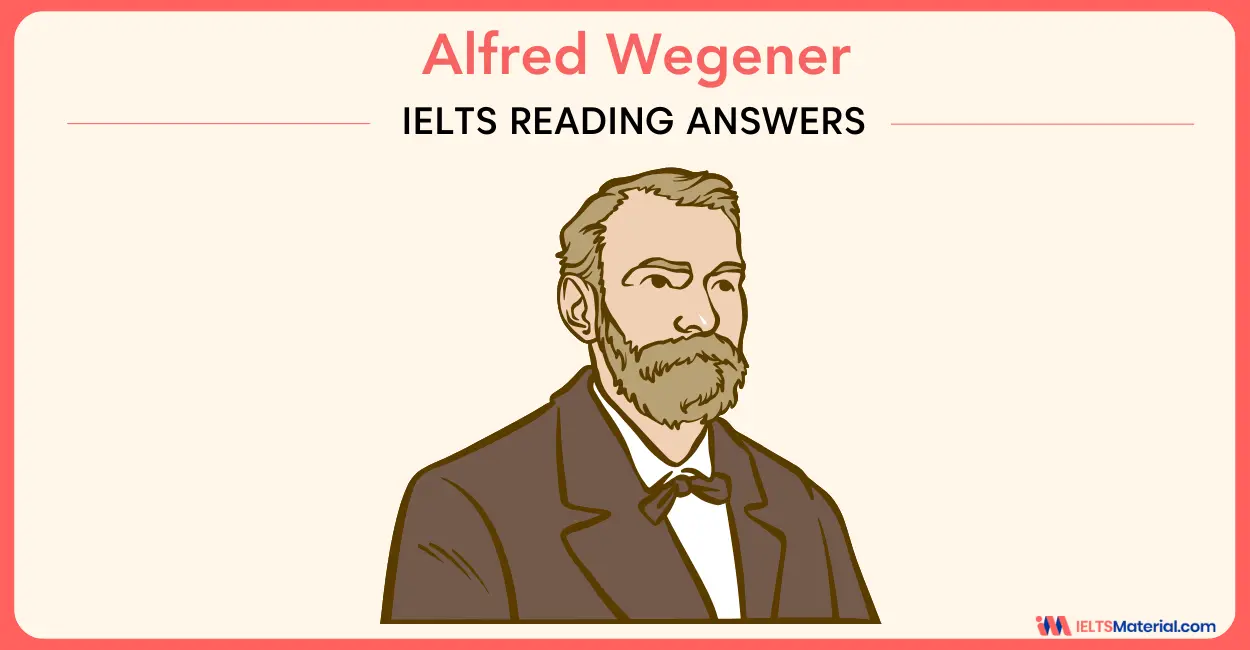Alfred Wegener - IELTS Reading Answers
15 min read
Updated On
-
Copy link
Get ready to practice the Alfred Wegener IELTS Reading Answers and improve your IELTS Reading score. Find out how to handle different types of IELTS Reading questions, along with answers and explanations & be prepared to achieve your desired Band 9 score.
Table of Contents

Limited-Time Offer : Access a FREE 10-Day IELTS Study Plan!
IELTS Reading can be challenging as you have to solve three passages within a limited time. However, you can be solved if you improve your comprehension skills by taking single passages from IELTS recent actual tests, like ‘Alfred Wegener IELTS Reading Answers’ and building confidence to overcome the challenges.
So, solve the Alfred Wegener Reading Answers given here to learn how to evaluate your answers using the given answer location and explanation, and adjust your approach based on performance and the given tips in this blog.
Reading Passage for Alfred Wegener Reading Answers
Go through the Alfred Wegener IELTS Reading Answers passage given below and prepare yourself for the reading section with similar IELTS Reading topics for General and Academic.
Alfred Wegener: science, exploration and the theory of continental drift by Mott T. Greene
A This is a book about the life and scientific work of Alfred Wegener, whose reputation today rests with his theory of continental displacements, better known as ‘continental drift’. Wegener proposed this theory in 1912 and developed it extensively for nearly 20 years. His book on the subject, The Origin of Continents and Oceans, went through four editions and was the focus of an international controversy in his lifetime and for some years after his death.
B Wegener’s basic idea was that many mysteries about the Earth’s history could be solved if one supposed that the continents moved laterally, rather than supposing that they remained fixed in place. Wegener showed in great detail how such continental movements were plausible and how they worked, using evidence from a large number of sciences including geology, geophysics, paleontology, and climatology.
C Wegener’s idea – that the continents move – is at the heart of the theory that guides Earth sciences today: namely plate tectonics. Plate tectonics is in many respects quite different from Wegener’s proposal, in the same way that modern evolutionary theory is very different from the ideas Charles Darwin proposed in the 1850s about biological evolution. Yet plate tectonics is a descendant of Alfred Wegener’s theory of continental drift, in quite the same way that modern evolutionary theory is a descendant of Darwin’s theory of natural selection.
D When I started writing about Wegener’s life and work, one of the most intriguing things about him for me was that, although he came up with a theory on continental drift, he was not a geologist. He trained as an astronomer and pursued a career in atmospheric physics. When he proposed the theory of continental displacements in 1912, he was a lecturer in physics and astronomy at the University of Marburg, in southern Germany.
E However, he was not an ‘unknown’. In 1906 he had set a world record (with his brother Kurt) for time aloft in a hot-air balloon: 52 hours. Between 1906 and 1908 he had taken part in a highly publicized and extremely dangerous expedition to the coast of northeast Greenland. He had also made a name for himself amongst a small circle of meteorologists and atmospheric physicists in Germany as the author of a textbook, Thermodynamics of the Atmosphere (1911), and of a number of interesting scientific papers.
F As important as Wegener’s work on continental drift has turned out to be, it was largely a sideline to his interest in atmospheric physics, geophysics, and paleoclimatology*, and thus I have been at great pains to put Wegener’s work on continental drift in the larger context of his other scientific work, and in the even larger context of atmospheric sciences in his lifetime.
G This is a ‘continental drift book’ only to the extent that Wegener was interested in that topic and later became famous for it. My treatment of his other scientific work is no less detailed, though I certainly have devoted more attention to the reception of his ideas on continental displacement, as they were much more controversial than his other work.
H Readers interested in the specific detail of Wegener’s career will see that he often stopped pursuing a given line of investigation (sometimes for years on end), only to pick it up later. I have tried to provide guideposts to his rapidly shifting interests by characterizing different phases of his life as careers in different sciences, which is reflected in the titles of the chapters.
I Thus, the index should be a sufficient guide for those interested in a particular aspect of Wegener’s life but perhaps not all of it. My own feeling, however, is that the parts do not make as much sense on their own as do all of his activities taken together. In this respect I urge readers to try to experience Wegener’s life as he lived it, with all the interruptions, changes of mind, and renewed efforts this entailed.
J Wegener left behind a few published works but, as was standard practice, these reported the results of his work – not the journey he took to reach at point. Only a few hundred of the many thousands of letters he wrote and received in his lifetime have survived and he didn’t keep notebooks or diaries that recorded his life and activities. He was not active (with a few exceptions) in scientific societies, and did not seek to find influence or advance his ideas through professional contacts and politics, spending most of his time at home in his study reading and writing, or the field collecting observations.
K Some famous scientists, such as Newton, Darwin, and Einstein, left mountains of written material behind, hundreds of notebooks and letters numbering in the tens of thousands. Others, like Michael Faraday, left extensive journals of their thoughts and speculations, parallel to their scientific notebooks. The more such material a scientist leaves
behind, the better chance a biographer has of forming an accurate picture of how a scientist’s ideas took shape and evolved.
L I am firmly of the opinion that most of us, Wegener included, are not in any real sense the authors of our own lives. We plan, think, and act, often with apparent freedom, but most of the time our lives ‘happen to us’, and we only retrospectively turn this happenstance into a coherent narrative of fulfilled intentions. This book, therefore, is a story both of the life and scientific work that Alfred Wegener planned and intended and of the life and scientific work that actually ‘happened to him’. These are, as I think you will soon see, not always the same thing.
Questions for Alfred Wegener Reading Answers
The IELTS Academic passage, Alfred Wegener IELTS Reading Answers, consists of 14 questions designed to enhance your reading skills and boost your overall band score. The question types found in this passage are:
- IELTS Reading Yes/No/Not Given (Q. 1-4)
- IELTS Reading Summary Completion (Q. 5-10)
- IELTS Reading Multiple Choice Questions (Q. 11-14)
Questions 1 – 4
Do the following statements agree with the views of the writer in the Reading Passage?
In boxes 1-4 on your answer sheet, write
YES – if the statement agrees with the views of the writer
NO – if the statement contradicts the views of the writer
NOT GIVEN – if it is impossible to say what the writer thinks about this
1 Wegener’s ideas about continental drift were widely disputed while he was alive.
2 The idea that the continents remained fixed in place was defended in a number of respected scientific publications.
3 Wegener relied on a limited range of scientific fields to support his theory of continental drift.
4 The similarities between Wegener’s theory of continental drift and modern-day plate tectonics are enormous.
Questions 5 – 10
Write the correct letter, A-J in the boxes 5-10 on your answer sheet.
Wegener’s life and work
One of the remarkable things about Wegener from a 5…………… is that although he proposed a theory of continental drift, he was not a geologist. His 6………………… were limited to atmospheric physics. However, at the time he proposed his theory of continental drift in 1912, he was already a person of 7……………. Six years previously, there had been his 8………………… of 52 hours in a hot-air balloon, followed by his well-publicized but 9………………… off Greenland’s coast. With the publication of his textbook on thermodynamics, he had also come the attention of a 10.……………….. of Gorman scientists.
A modest fame
B vast range
C record-breaking achievement
D research methods
E select group
F professional interests
G scientific debate
H hazardous exploration
I biographer’s perspective
J narrow investigation
Questions 11-14
Write the correct letter in the boxes 11-14 on your sheet.
11 What is Mott T Greene doing in the fifth paragraph?
A describing what motivated him to write the book.
B explaining why it is desirable to read the whole book.
C suggesting why Wegener pursued so many different careers.
D indicating what aspects of Wegener’s life interested him most.
12 What is said about Wegener in the sixth paragraph?
A He was not a particularly ambitious person.
B He kept a record of all his scientific observations.
C He did not adopt many of the scientific practices of the time.
D He enjoyed discussing new discoveries with other scientists.
13 What does Greene say about some other famous scientists?
A Their published works had a greater impact than Wegener’s did.
B They had fewer doubts about their scientific ideas than Wegener did.
C Their scientific ideas were more controversial than Wegener’s.
D They are easier subjects to write about than Wegener.
14 What is Greene’s main point in the final paragraph?
A It is not enough in life to have good intentions.
B People need to plan carefully if they want to succeed.
C People have little control over many aspects of their lives.
D It is important that people ensure they have the freedom to act
Unlock quick strategies to tackle passages like ‘Alfred Wegener’ in just 20 minutes.
Join our FREE IELTS webinars!
Answers for Alfred Wegener with Location and Explanations
Check your answers using the answer key below for the Alfred Wegener IELTS Reading passage. Make sure to create customized strategies from the feedback from this practice and master IELTS Reading question types with examples.
1 Answer: Yes
Question type: Yes/No/Not Given
Answer Location: Paragraph A, Lines 3-4
Answer Explanation: Take a look at this line from Paragraph A, “ His book on the subject, The Origin of Continents and Oceans, went through four editions and was the focus of an international controversy in his lifetime and for some years after his death….”.The statement suggests that his book remained controversial throughout his lifetime. Hence, the answer is ‘Yes’.
2 Answer: Not Given
Question type: Yes/No/Not Given
Answer Location: N/A
Answer Explanation: The information mentioned in the statement is not found in the passage.
3 Answer: No
Question type: Yes/No/Not Given
Answer Location: Paragraph B, Lines 1-2
Answer Explanation: Look at this line,’ Wegener’s basic idea was that many mysteries about the Earth’s history could be solved if one supposed that the continents moved laterally, rather than supposing that they remained fixed in place….”. The writer suggests that Wegener’s fundamental concept was that many mysteries about Earth’s history could be resolved by assuming that continents moved horizontally, rather than assuming they stayed stationary. Hence, the answer is ‘No’.
4 Answer: No
Question type: Yes/No/Not Given
Answer Location: Paragraph C, Line 2-3
Answer Explanation: Take a look at this line from Paragraph C, “ Plate tectonics is in many respects quite different from Wegener’s proposal, in the same way that modern evolutionary theory is very…”It is mentioned that Plate tectonics differs significantly from Wegener’s proposal, just as modern evolutionary theory differs from Charles Darwin’s ideas about biological evolution in the 1850s. Hence, the answer is ‘No’.
5 Answer: I
Question type: Summary Completion
Answer Location: Paragraph D, Line 1
Answer Explanation: It was mentioned in this line that, “When I started writing about Wegener’s life and work, one of the most intriguing things about him for me was that….” with the focus on Wegener, the writer provides a biographer’s perspective. Hence, the answer is ‘I’.
6 Answer: F
Question type: Summary Completion
Answer Location: Paragraph D, Lines 2-3
Answer Explanation: Take a look at this line, “…He trained as an astronomer and pursued a career in atmospheric physics…” The writer notes that Wegener was trained as an astronomer and pursued a career in atmospheric physics.Hence, the answer is ‘F’.
7 Answer: A
Question type: Summary Completion
Answer Location: Paragraph D, Lines 4-5
Answer Explanation: In this line of Paragraph D, “When he proposed the theory of continental displacements in 1912, he was a lecturer in physics and astronomy at the University of Marburg, in southern Germany…” As per the writer, when he introduced the theory of continental displacements in 1912, Wegener held a position as a lecturer in physics and astronomy at the University of Marburg. Hence the answer is ‘A’.
8 Answer: C
Question type: Summary Completion
Answer Location: Paragraph E, Lines 1-2
Answer Explanation: Take a look at this line, “ In 1906 he had set a world record (with his brother Kurt) for time aloft in a hot-air balloon: 52 hours..”As per the writer, Wegener was not an ‘unknown’. In 1906, he and his brother Kurt set a world record for time aloft in a hot-air balloon, staying airborne for 52 hours. Hence, the answer is ‘C’.
9 Answer: H
Question type: Summary Completion
Answer Location: Paragraph E, Lines 2-3
Answer Explanation: In this line of Paragraph E it is mentioned that, “Between 1906 and 1908 he had taken part in a highly publicized and extremely dangerous expedition to the coast of northeast Greenland…”As stated by the writer, between 1906 and 1908, Wegener participated in a highly publicized and exceptionally perilous expedition to the coast of northeast Greenland. Hence, the answer is ‘H’.
10 Answer: E
Question type: Summary Completion
Answer Location: Paragraph E, Lines 4-5
Answer Explanation: Take a look at this line, “He had also made a name for himself amongst a small circle of meteorologists and atmospheric physicists in Germany as the author of a textbook, Thermodynamics of the Atmosphere (1911)…”The writer notes that Wegener had gained recognition among German meteorologists and atmospheric physicists. He authored the textbook “Thermodynamics of the Atmosphere” (1911) and several scientific papers. Hence the answer is ‘E’.
11 Answer: B
Question type: Multiple-Choice Questions
Answer Location: Paragraph E, Lines 4-5
Answer Explanation: Have a look at this line,”..He had also made a name for himself amongst a small circle of meteorologists and atmospheric physicists in Germany as the author of a textbook..” The author points out Wegener’s achievements, like setting a world record and gaining recognition from German experts, suggesting why readers should engage with the book. Hence the answer is ‘B’.
12 Answer: A
Question type: Multiple-Choice Questions
Answer Location: Paragraph H, Line 1
Answer Explanation: Take a look at the first line of Paragraph H, “ Readers interested in the specific detail of Wegener’s career will see that he often stopped pursuing a given line of investigation..” It is clear in this line that readers interested in Wegener’s career specifics will note his tendency to intermittently halt pursuits of certain investigations for extended periods, only to resume them later. Hence, The answer is ‘A’.
13 Answer: D
Question type: Multiple-Choice Questions
Answer Location: Paragraph K, Lines 1-2
Answer Explanation: It is mentioned in this line that, “.. Some famous scientists, such as Newton, Darwin, and Einstein, left mountains of written material behind, hundreds of notebooks..”The writer mentions famous scientists like Newton, Darwin, and Einstein who left behind extensive written records, including notebooks and letters. Similarly, Michael Faraday also left detailed journals alongside his scientific notes. Hence, the answer is ‘D’.
14 Answer: C
Question type: Multiple-Choice Questions
Answer Location: Paragraph L, Lines 1-2
Answer Explanation: Take a look at this line, “I am firmly of the opinion that most of us, Wegener included, are not in any real sense the authors of our own lives…”The writer believes that Wegener, like many of us, didn’t entirely control his life’s direction. While we plan and act with apparent freedom, life often unfolds unexpectedly. It’s only afterward that we construct a coherent narrative from these experiences. Hence the answer is ‘C’.
Want to improve your IELTS Academic Reading score?
Tips to Solve the Question Types in Alfred Wegener Reading Answers
Since now you know the answers of Alfred Wegener, let us check out some quick IELTS Reading tips and techniques to increase your reading speed and achieve a top reading band score.
Yes/No/Not Given
You’ll read a passage followed by statements. Your task is to determine if each statement agrees with the passage (Yes), disagrees (No), or if the passage doesn’t address it (Not Given).
- Understand the Options by knowing that ‘Yes’ means the information is directly stated in the passage, ‘No’ means it contradicts the passage, and ‘Not Given’ means it isn’t mentioned in the passage.
- For each statement, refer to the passage and find the relevant information. Pay close attention to the wording and compare it to the statement.
- Watch for paraphrasing because sometimes the statement is paraphrased in the passage. Look for synonyms and rephrase sentences.
- Focus on keywords by identifying them in the statement and looking for those exact words or synonyms in the passage.
- Beware of distractors since the passage may include information that seems related but doesn’t directly address the statement. Make sure the answer matches the statement directly.
- Read around the statement because sometimes the context can help determine if the information is ‘Yes,’ ‘No,’ or ‘Not Given.’
Summary Completion
Some tips to answer the IELTS Reading summary completion questions and obtain a high band in IELTS Academic Reading are given below:
- Try predicting the answers even before you glance at the given options.This will assist you find the correct answer.
- Find out whether the gap has to be filled with an adverb, adjective, noun or verb. You would have selected the wrong answer if your sentence is grammatically wrong.
- Find synonyms as well as paraphrases in the text instead of words that seem directly matching.
- Don’t spend a lot of time looking for an answer to just one question. If you are unable to find it, move on to the next. Focus more on the easy answers.
Normally, the answers would come in the similar order as that of the questions. - If you have received a list of words, try to think about those that cannot be correct as per their grammar or meaning. Then, you can remove these words.
Multiple Choice Questions
You will be given a reading passage followed by several questions. Your task is to understand the question and to select the best solution from the available possibilities.
- Before reading the passage, read the question and select the keywords. Check the keyword possibilities if the question statement is short on information.
- Then, using the keywords, read the passage to find the relevant information.
- To select the correct option, carefully read the relevant words and match them with each option.
- You will find several options with keywords that do not correspond to the information.
- Try opting for the elimination method mostly.
- Find the best option by matching the meaning rather than just the keywords.
Well done on attempting to solve the reading passage! To crack IELTS Reading in the first go, try solving more of the recent IELTS Reading practice tests here. You will improve your reading speed, become familiar with the types of questions, and strengthen your ability to find information, all of which are critical for achieving a high IELTS band score.
Useful Links:
- The Growth of Intelligence – IELTS Reading Answers
- What Does the Consumer Think?- IELTS Reading Answers
- Having a Laugh – IELTS Reading Answers
- The Awesome Banana – IELTS Reading Answers
- Useful IELTS Reading Articles, Website Resources and Material for Academic and General Training
- 101 IELTS Academic Reading Past Test Papers with Answers PDF Download
- How to Improve IELTS Reading Score from 5 to 7 in 30 Days?
Practice IELTS Reading based on question types

Start Preparing for IELTS: Get Your 10-Day Study Plan Today!
Explore other Reading Practice Tests

Nehasri Ravishenbagam

Nehasri Ravishenbagam

Kasturika Samanta

Kasturika Samanta
Recent Articles

Nehasri Ravishenbagam

Haniya Yashfeen

Haniya Yashfeen

Haniya Yashfeen




Post your Comments